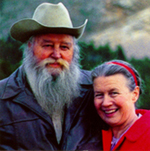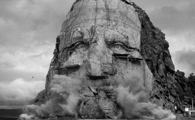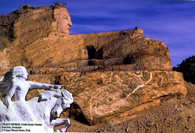Sculpture Northwest obtained Mr. Joseph’s permission to reprint this article here as it appeared in The Elks Magazine, July/August 2003.
On September 6, 1877, under a flag of truce, a United States soldier killed the great Lakota chief Crazy Horse by ramming a bayonet numerous times into his side and finally into his back. Crazy Horse’s crime was helping to defeat George Armstrong Custer at the Battle of the Little Bighorn.
In Boston, on September 6, l908, the mountain sculptor Korczak Ziolkowski was born to Polish immigrant parents. It’s intriguing that 31 years to the day separate Crazy Horse’s death and Korczak Ziolkowski’s birth because the two will be together in pegmatite granite for millennia to come. Until the age of eighteen, Crazy Horse’s name was Curly. While his people thought he was strange because he spent so much time alone, they also believed he had magical powers. His father, a medicine man, went by the name of Crazy Horse. For the Sioux, the word “crazy” implied a mad love for something, especially of one’s people.
Curly’s mysticism so pleased his father that one evening he called the tribe together. Korczak Ziolkowski narrated what Crazy Horse said at this meeting in the following way, “You all know I have two sons and one daughter, and one son you know as Curly. I am very proud of Curly. I cannot give him anything, but I am so proud of him I want to give him myself. From today on I will be known as Worm and my son will be known as Crazy Horse.”
Whenever Korczak told this story his eyes would fill with tears. As a foster child he had not known a father’s love, and this act of giving by Crazy Horse’s father moved him deeply.
Raised in a series of foster homes after his parents died in a boating accident before he was a year old, Korczak was ultimately raised by an Irish prizefighter. The relationship between Korczak and his keeper was rocky, and Korczak vowed to exchange blows with him when he turned 16. Korczak did eventually fight the boxer, but he lost the battle and subsequently left home to work on the waterfront.
Three years earlier, while still living at home, Korczak had read a magazine article that fired his imagination. The piece was about the famous mountain sculptor, Gutzon Borglum, who would eventually carve Mount Rushmore.
Inspired by what he had read about Borglum, Korczak taught himself the art of sculpture. Even though he had no formal training, he won first prize at the l939 New York World’s Fair for his marble portrait of Paderewski the Polish pianist and statesman. After winning the award, Ziolkowski continued to work with stone and wood, and his talent earned him critical acclaim.
Korczak Ziolkowski first saw the Black Hills of South Dakota when he was invited to work with Borglum at Mount Rushmore in l939. Although he worked with Borglum only a short time, Korczak learned a great deal from him that was invaluable in his future career as a mountain sculptor.

In the l930s, Chief Henry Standing Bear, a Brule Indian, watched Mount Rushmore being carved. In l939 he eventually wrote Korczak a letter stating, “My fellow chiefs and I would like the white man to know that the red man has great heroes, too.”
The chief visited Korczak at West Hartford, Connecticut, in l941 and again invited the sculptor to honor Crazy Horse in stone. Five years later after returning from WWII, Korczak agreed to do so in a mountain 17 miles from Mount Rushmore.
Korczak returned to the Black Hills on May 32, l947, to begin his work. Although he had only $l74 in his pocket, he decided not only to carve Crazy Horse’s face, but to also sculpt a three-dimensional monument of him upon a horse.
According to Korczak’s plans, the finished colossus would be 563 feet high (taller than the highest pyramid in Egypt) and 641 feet long, making it longer that two football fields placed end to end. When completed, Crazy Horse would be the largest sculpture ever.
Crazy Horse once said, “My lands are where my dead lie buried.” Korczak wanted his monument to the remarkable chief to show Crazy Horse seated on his steed pointing to the sacred lands of the Lakota. Korczak’s original scale model of the finished mountain was small, but he eventually created a much larger representation that stands 20 feet and weighs 16 tons.
At first Korczak used a series of ropes to reach the top of the mountain, but later constructed 741 step wooden stair case to make the climb easier. He then built a 2,040 foot pipeline for his 24 year old air compressor, a machine that allowed him to drill dynamite holes more easily. The compressor often conked out when Korczak was on the top of the mountain, which meant he would have to go back down the 741 step wooden staircase to restart it. One day he had to make the trip down and back up the mountain nine times.
A picture of Korczak taken just after he started the project shows him standing at the top of Crazy Horse Mountain with his shirt off, wearing a cowboy hat. He has a chisel in one hand and a small sledgehammer in the other: a 20th century Don Quixote chipping away at a granite windmill taller than the Washington Monument.
Throughout his life, Korczak often spoke about his commitment to his dream: “The world asks you one question, only one. The world asks you, ‘did you do the job?’ And in my book, there is only one answer, ‘Yes!’ You don’t answer, ‘I would have done the job if I had the money...I would have done the job if people had been sympathetic or understood what I was trying to do...I would have done the job if I hadn’t gotten hurt or crippled.’ And God knows I have been crippled.
You don’t even say, ‘I would have done the job if I hadn’t died’ I don’t buy it. There is only one answer, ‘Yes!’”
By the time he died in October l982 at the age of 74, Korczak had blasted several million tons of granite from the mountain to block out a rough outline of the gigantic monument. After Korczak’s death, his family placed his remains in a tomb Korczak and his sons had carved in an outcropping in front of Crazy Horse Mountain.
Even with his passing, Korczak’s dream is becoming a reality. His large family—he and his spouse, Ruth, had ten children—continues to work on the mountain. The Ziolkowski family completed Crazy Horse’s face in l998 and dedicated it on June 3 of that year, exactly 50 years after Korczak detonated the first dynamite charge that blew away what now seems like a paltry ten tons of rock from the top of the mountain.
Work has begun on the horse’s head, which will stand 219 feet high, and will be nearly four times the size of Crazy Horse’s face. At present there is no time frame for finishing the mountain sculpture because its completion depends on funding and weather conditions. And the project is much more than the mountain.
The Crazy Horse Memorial is a nonprofit educational and cultural project. It receives absolutely no federal funding. The Indian Museum of North America, which contains thousands of artifacts, is already open in the visitors receiving area, and there are plans to build near the mountain a University and Medical Training Center for the North American Indians. The Crazy Horse Memorial, and the entire complex surrounding it, honors all of the North American Indian tribes.

